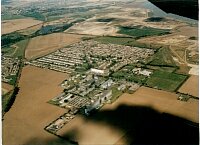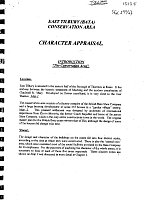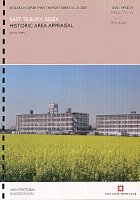| Name: | Bata Estate - Factory and Model Settlement |
|---|
| SMR Number: | 15138 |
|---|
| Type of record: | Monument |
|---|
| Grid Reference: | TQ 680 785 |
|---|
| Map Sheet: | TQ67NE |
|---|
| Parish: | East Tilbury, THURROCK, ESSEX |
|---|
| THURROCK, ESSEX |
|---|
Summary
Factory and Model Settlement designed by Gahura and Karfik.
Full description
Factory and model settlement laid out on grid iron plan in the 1930's. Designed by Czechoslovakian architects Frantizek Gahura and Vladimir Karfik in the International Modern Movement Style. Factory is of rectangular plan with re-inforced concrete frame. Houses constructed with concrete poured lifts of roughly one metre in height. Recreation facilities also provided. <1> This site is part of the East Tilbury (BATA) conservation area. The conservation area consists of a factory complex of the British Bata Shoe Company and a large housing development of some 352 houses in a 'garden village' setting. This planned settlement was designed by architects of international importance from Zlin in Moravia, the former Czech Republic and home of the parent Shoe Company, which is the only entire constructivist town in the world. The original master plan for the British Bata estate mirrors that of Zlin, although the design of some of the houses did change with time. The original plan shows a development many times bigger than the estate today and would have constituted a complete new town on par with the parent company in Zlin. The housing was built in stages between 1933 and the mid 1960's. All the social facilities necessary were provided by the company for their employees including a cinema and sports facilities. The factory complex consists of 13 large buildings which were built between 1933 and the late 1950's.<2> Aerial photograph <3>. Some of the buildings are listed see individual records for details.
Site Assessment: Exceptionally early and complete example of the International Style building in Britain.
Article on Bata Company from unknown source.<4>
Tomas Bata was a early convert to modernism as shown by the assembly line approach he used for his factories, adopted following a visit to Henry Fords vast car plant in the USA. He commisioned architectural gems such as the Bata Store in Prague and was responsible for the transformation of his own home town of Zlin into a workers 'utopia' of 45,000 based on contemporary examples like Letchworth in Herts. He employed Czech architects, Jan Kotera, Franisek Gahura and Vladimir Karfik (the latter worked with Le Corbusier and Frank Llyod Wright). Tomas Bata died in a airplane crash in 1933 but his brother Jan, took over the company. Work started on the settlement at Tilbury in 1932 to designs by Czech architects and following the Zlin blueprint. East Tilbury was built with a cinema, restaurant, sport facilities , garage, farm, shops and a PO. The town had its own newspaper and there were many activities and facilities. Unusual for the time Bata residents were provided with modern houses each with a inside bathroom, heating and electricity, but the flip side was that if yoy lost your job you also lost your home. The residents were encouraged to maintain the appearance of the properties and the neighbourhood in general and there was a gardening competition every summer. However if your garden wasn’t up to scratch you were told in no uncertain terms to sort it out. <5>
This is a complete planned industrial settlement centred around the British Bata Shoe Co., established in East Tilbury by the Czech Tomas Bata in 1933. Bata provided all the housing and social needs of the workforce - over 300 houses, a hotel, four dormitory buildings, shops, swimming pool, memorial gardens, orchard, sports facilities, college, fire station and a 300 acre farm. The settlement at Tilbury was based on another Bata development at Zlin in Moravia designed by modernist architects Vladimir Karfik and Frantizek L. Gahura. The majority of the rendered or painted brick flat roofed houses, with the exception of those built after 1959 are in the Modernist style. The first Czech designed houses were built in Bata Avenue by 1933 and were followed by three parallel roads (Thomas Bata, King George VI and Queen Elizabeth Avenues) of modernist houses built before and after WW2. These later houses varied slightly according to status, providing different internal layouts and larger executive houses, the latter built with extended frontages and a first floor balcony. Pre-war rents for small houses were 10/- (50p) per week, the larger ones were 25/- (£1.25p) per week. Successive developments along Princess Avenue and Gloucester Avenue in 1959 and 1966 moved away from the flat roofed modern architecture and adopted a more conventional pitched roof design. The housing has now been sold either to individuals or housing trusts and the factory is now closed.
ARCHAEOLOGICAL POTENTIAL
The estate remains in its original form and most of the houses and other community facilities remain. External integrity has been largely maintained although internal inspection is required to assess the original configurations.
SITE SIGNIFICANCE
This is a mid C20 planned company village consisting of housing and community facilities built around the factory. Much of the architecture is Modern Movement based on the Czech model at Zlin. Integrity of layout and design are all retained.
CURRENT STATUS
Conservation Area and Nos. 2, 4-6, 8-10, 12-14,
16-18, 24-26, 28-30 and 32-34 Bata Avenue all listed Grade II
RECOMMENDED ACTION
Maintain current status and consider the listing of more individual buildings as typical examples. The settlement as a whole and in particular those buildings potentially at threat, such as the redundant factory buildings should be duly recognized and protected in the Conservation Area Plan. If large scale development is proposed in the area of East Tilbury, its importance should be considered as part of the Master Plan Development (MPD).
MANAGEMENT
All these houses continue in residential use and as such are well maintained. Internal inspection to assess original spatial configuration is recommended when the opportunity arises.
GRADING**** <6>
<1> Gould, Shane, 1996, Bata Estate - AIA Index Record for Industrial Sites (DESC TEXT). SEX59946.
<2> Thurrock Borough Council?, 1997 ?, East Tilbury (BATA) Conservation Area Character Appraisal (DESC TEXT). SEX59947.
<3> unknown, 1975, 214 (AP). SEX59948.
<4> Sedlak, J, unknown, The Bata Company (DESC TEXT). SEX63775.
<5> Rose, Steve, 2005, Welcome to Bata-ville (DESC TEXT). SEX65359.
<6> Crosby, Tony, Garwood, Adam and Corder-Birch, Adrian, 2006, Industrial Housing In Essex, An archaeological, architectural and historic appraisal of housing provided by Industry (DESC TEXT). SEX65399.
<7> Saunders, Helen, 2006, CP/06/26/07-09, 3 frames, 3/11/06 (AP). SEX66866.
<8> Smith, Joanna, 2007, East Tilbury, Essex - Historic Area Appraisal, mentioned in appraisal (DESC TEXT). SEX70042.
Monument Types
- HOUSING ESTATE (1930, Modern - 1930 AD to 2050 AD)
- SHOE FACTORY (1930, Modern - 1930 AD to 1996 AD)
- LEATHER FACTORY (Modern - 1936 AD to 1996 AD)
- RUBBER WORKS (Modern - 1938 AD to 1996 AD)
Associated Events
- Industrial Housing In Essex, An Archaeological, Architectural and Historical Survey and appraisal of housing provided by Industry. (Ref: ?)
- East Tilbury, Essex, Historic Area Appraisal (Ref: ISSN 1749-8775)
Protected Status
- Historic Environment Character Zone: Thames Gateway 111_11
- Conservation Area: East Tilbury
- Historic Environment Character Zone: Thames Gateway 111_7
- Historic Environment Character Area: Thames Gateway 111
Sources and further reading
| <1> | DESC TEXT: Gould, Shane. 1996. Bata Estate - AIA Index Record for Industrial Sites. |
| <2> | DESC TEXT: Thurrock Borough Council?. 1997 ?. East Tilbury (BATA) Conservation Area Character Appraisal. |
| <3> | AP: unknown. 1975. 214. |
| <4> | DESC TEXT: Sedlak, J. unknown. The Bata Company. |
| <5> | DESC TEXT: Rose, Steve. 2005. Welcome to Bata-ville. |
| <6> | DESC TEXT: Crosby, Tony, Garwood, Adam and Corder-Birch, Adrian. 2006. Industrial Housing In Essex, An archaeological, architectural and historic appraisal of housing provided by Industry. |
| <7> | AP: Saunders, Helen. 2006. CP/06/26/07-09. 3 frames, 3/11/06. |
| <8> | DESC TEXT: Smith, Joanna. 2007. East Tilbury, Essex - Historic Area Appraisal. mentioned in appraisal. |
Related records
| 35323 | Parent of: 12 to 14 Bata Avenue (Listed Building) |
| 35324 | Parent of: 16 and 18 Bata Avenue (Listed Building) |
| 35321 | Parent of: 2 Bata Avenue (Listed Building) |
| 35325 | Parent of: 24 and 26 Bata Avenue (Listed Building) |
| 35326 | Parent of: 28 and 30 Bata Avenue (Listed Building) |
| 35327 | Parent of: 32 and 34 Bata Avenue (Listed Building) |
| 39303 | Parent of: 4 and 6 Bata Avenue (Listed Building) |
| 35322 | Parent of: 8 and 10 Bata Avenue (Listed Building) |
| 35320 | Parent of: Building 13 Bata Factory (Listed Building) |
Images
 Factory and Model Settlement, Bata Estate, Thurrock © Essex County Council |  Bata Estate, Thurrock © Essex County Council |
 Bata Estate, Thurrock © Essex County Council |  No image description available © Essex County Council |
 No image description available © Essex County Council | |
Search results generated by the HBSMR Gateway from exeGesIS SDM Ltd.